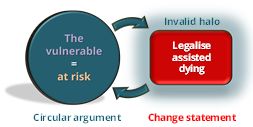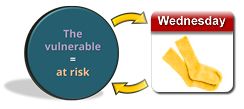"Vulnerable at risk" flapdoodle - the Full Monty
“The vulnerable will be at risk if we legalise assisted dying.”
This silly, nonsensical statement (flapdoodle) is promoted frequently and persistently in opposition to assisted dying law reform. Various forms are advanced not only by lobbyists, commentators, journalists and politicians, but even by judges and professional medical bodies (see the Appendix).
But why is this statement, and ones like it, just so much flapdoodle? The reason is because it’s false and self-serving rhetoric dressed up as a profound or self-evidential truth. Here’s the Full Monty on how this simple deception works.
What’s the argument?
The argument is structured in such a way that an original group (in this case ‘the vulnerable’) is claimed to morph into a new, different group (those ‘at risk’) on the basis of some approved or disapproved action introduced as a change statement (‘legalise assisted dying’). It takes the form of a supposedly consequentialist argument as shown in Figure 1.
 Figure 1: A supposedly consequentialist argument.
Figure 1: A supposedly consequentialist argument.
But the argument's a complete sham. Why?
What's the sham?
A quick check of the definition of ‘vulnerable’ reveals the real answer. The Oxford dictionary says "at risk". Dictionary.com offers “susceptible”, and Merriam-Webster defines it as “open to harm”. So, the two groups are in fact one and the same cohort as shown in Figure 2.
 Figure 2: The ‘original’ and ‘new’ groups are in fact identical.
Figure 2: The ‘original’ and ‘new’ groups are in fact identical.
It is a circular sham—a tautology or rhetorical pretence—to claim that a group defined as at risk, susceptible or open to harm will become at risk, susceptible or open to harm, as a consequence of some argued change statement. The same thing applies to ‘the weak’, who by context are ‘the vulnerable’ or ‘those at risk’.
Through its self-truth, the circular group claim wrongly lends the change statement’s claim a halo of validity, rendering it intuitively (even seductively) but falsely attractive, as shown in Figure 3.
 Figure 3: The circular group claim wrongly casts a halo of ‘validity’ on the change statement’s claim.
Figure 3: The circular group claim wrongly casts a halo of ‘validity’ on the change statement’s claim.
Principle and examples of the sham
So, in principle, this rhetorical sleight of hand takes the form:
Group A becomes same Group B if dis/approved change.
[ The circular sham ] Change statement
The claim about assisted dying can be seen for what it is, a proposal basking in ‘self-proving’ rhetoric:
“The vulnerable will be at risk if we legalise assisted dying.”
Let’s make the principle absolutely clear with some further examples:
- You want people to reject democracy.
“The self-interested will promote their own agenda if we hold so-called ‘democratic’ elections.”
Analysis: the ‘self-interested’ are one and the same people who vigorously ‘promote their own agenda’ and so it proves nothing about democratic elections despite the attractiveness of wanting to minimise self-interest—which is presented here as only possibly negative. Note also the pejorative expression ‘so-called’ and placing ‘democratic’ in quote marks so as to also tarnish the reputation of free and fair elections.
- You are making a case to go to war.
“Our brave soldiers will be denied valour if we oppose this just war.”
Analysis: ‘bravery’ and ‘valour’ are the same thing, and something we esteem highly, regardless of whether this particular war is waged or not. Note that presenting the war as ‘just’ (i.e. ‘righteous’) compounds the ‘offence’ of denying brave soldiers the chance of valour.
- You want to compel people to attend church.
“If we allow people to skip church, the damned will be condemned to eternal hell.”
Analysis: by definition, the damned are condemned to eternal hell (assuming hell exists) regardless of whether people attend church or not. Might private prayer or a life of service to others—not just church attendance—help avoid eternal hell?
- You want ‘men’s entertainment galleries’ to be banned.
“Sexual predators will continue to abuse their prey unless we ban table-top dance bars.”
Analysis: Sexual predators by definition abuse prey whether table-top dance bars exist or not.
How does the sham fool us so easily?
How is it that the ‘proof’ of the circular group reference so easily transfers a halo of validity to the change statement?
It does so by the close and intuitive relationship of the group topic to the change statement topic—in the main case, death, and in the further examples: political system; war; religion; sex. When the group and change statement topics are closely related, the nature of the change statement doesn’t trigger critical examination and we are likely to automatically accept the effect of the change statement as intrinsically true and meaningful, when it’s not.
How do I spot the sham easily?
To test a statement for the circular sham, simply replace the topic-related change statement with an unrelated one, for example:
“Sexual predators will continue to abuse their prey unless we put a price on carbon.”
Heavens! In order to protect people from sex crimes we must put a price on carbon!
“The vulnerable will be at risk if we wear yellow socks on Wednesdays.”
 Figure 4: To protect the vulnerable from being at risk, we must outlaw the wearing of yellow socks on Wednesdays.
Figure 4: To protect the vulnerable from being at risk, we must outlaw the wearing of yellow socks on Wednesdays.
It becomes immediately obvious, by replacing a related change statement topic with an unrelated one, just how invalid the halo effect is. The jarring topic difference triggers our critical faculties and we easily see through the sham.
What to do when you find the sham
Authentic and healthy community debate about weighty matters deserves better than misleading rhetoric.
If you encounter the flapdoodle of this circular sham, ask those making it to correct their error and advise them that:
“No proof is found by just going round.”
If you get no satisfaction, report the flapdoodle to us and we'll add it to our examples.
-----
Appendix: Real-world examples of assisted dying ‘vulnerable at risk’ flapdoodle
1. Medical journal headline
Dr Bill Noble (2013). ‘Legalising assisted dying puts vulnerable patients at risk and doctors must speak up.’ British Medical Journal 346: f4062.
2. Medical association television statement
Dr Gerard McGushin (for the Australian Medical Association) (2013), Channel 10 TV ‘The Project’, 16-Oct — ”Anyone who’s weak and vulnerable in our society will be at risk [from legalised assisted dying].”
3. Published book statement
Prof. Margaret Somerville (2014), ‘Death Talk: The case against euthanasia and physician-assisted suicide’, 2nd Ed., McGill-Queens University Press, Montreal — “… the community, especially its vulnerable members … legalized euthanasia … could place even their continued existence at risk” (Preface, p. 6 of 38, Kobo edition).
4. Supreme Court (Canada) determination
Rodriguez v. British Columbia (Attorney General), [1993] 3 SCR 519, “… persons who may be vulnerable to the influence of others … may find themselves at risk at the hand of others … [in the intentional termination of life]”, p. 558.
5. Magazine article
Bill Muehlenberg (2008), Quadrant Online, 3-Sep, https://quadrant.org.au/opinion/bill-muehlenberg/2008/09/some-objections-to-legalised-euthanasia/ (viewed 28-May-2014), “The most vulnerable will be at risk … with legalised euthanasia”.
6. Legislator’s speech in Parliament
Rev. Hon. Dr Gordon Moyes (2003), Speech by the Rev. Hon. Dr Gordon Moyes AC, MLC in the NSW Legislative Council Chamber on The Voluntary Euthanasia Trial (Referendum) Bill 2003, “The most vulnerable will be at risk … [from] voluntary euthanasia”.
7. British Medical Association Policy Statement on Assisted Dying
British Medical Association (2014), What is current BMA policy on assisted dying?, https://www.bma.org.uk/advice-and-support/ethics/end-of-life/the-bmas-position-on-physician-assisted-dying (viewed 28-May-2014), “Permitting assisted dying for some could put vulnerable people at risk”.
8. Newspaper quotes cleric
Rev. Dr Brendan McCarthy (2012), Assisted suicide comment: euthanasia puts the vulnerable at risk, https://www.telegraph.co.uk/news/uknews/law-and-order/9478399/Assisted-suicide-comment-euthanasia-puts-the-vulnerable-at-risk.html (viewed 28-May-2014).
9. Anti-euthanasia campaign website
Alex Schadenberg (2013), Assisted dying law would bring risks for the vulnerable, http://alexschadenberg.blogspot.com.au/2013/11/assisted-dying-law-would-bring-risks.html (viewed 28-May-2014).
10. Anti-euthanasia blog
Paul Russell (2012), Euthanasia: Vigilance needed to protect the vulnerable, Newsweekly, https://ncc.org.au/newsweekly/uncategorized/5226-euthanasia-vigilance-needed-to-protect-the-vulnerable/ (viewed 28-May-2014) — “…the whole question of vulnerable patients at risk…”. [only the affirmative is argued]
11. Anti-euthanasia campaign website
Euthanasia Prevention Coalition [now the Patients Rights Council] (2007), ‘Turning the Tide’ DVD has sold more than 1000 copies, Newsletter October 2007 — “…the question of whether euthanasia puts vulnerable patients at risk…”. [only the affirmative is argued]

